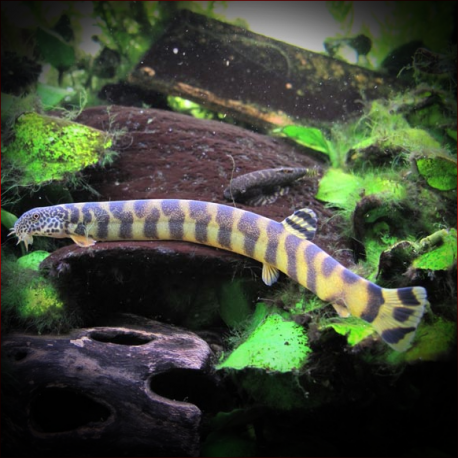More info
Datasheet
| Minimum Tank Size | 80 litres / 21.13 US gallons |
| Maximum Size | 12.0cm / 4.72inches |
| Temperature | 20°C / 68.00°F - 24°C / 75.20°F |
| Hardness | 0.00dgH / 0ppm - 8.01dgH / 143ppm |
| pH | 6.0-7.5 |
General Description
Kichulchoia multifasciata, also known as Niwella multifasciata, is a peaceful species that is not commonly found in the Western aquarium hobby. It can be distinguished from its congener, K. brevifasciata, by its unique body patterning, wrinkled lip surfaces, and shorter barbels. The species was originally classified under Cobitis but was later moved to Niwella due to oral morphology differences.
Aquarium Setup
To create a suitable environment for K. multifasciata, it is crucial to maintain clean, well-oxygenated water with a turnover rate of 10-15 times per hour. The tank should feature a substrate of gravel, sand, or a mixture of both, along with water-worn rocks, pebbles, driftwood, and aquatic plants like Microsorum, Crinum, and Anubias species. Given its need for stable water conditions and biofilm for feeding, a biologically mature aquarium is necessary, and a secure lid is advised to prevent jumping.
Behaviour
This species displays a peaceful demeanor, preferring the company of conspecifics. Encounters with aggressive or competitive tankmates should be avoided. K. multifasciata may exhibit jumping behavior, especially when introduced to a new environment, emphasizing the importance of a secure tank lid.
Feeding and Diet
In its natural habitat, K. multifasciata likely feeds on benthic algae and associated micro-organisms. In captivity, it accepts a diet of high-quality dried foods, live or frozen bloodworms, and homemade gelatin-bound foods rich in fresh vegetables and Spirulina. Providing algae-covered surfaces in the aquarium is ideal for long-term success, with the option of maintaining a separate tank for algae growth if needed.
Reproduction & Dimorphism
Information on the reproduction of K. multifasciata is currently unreported. Sexual dimorphism in this species includes the lack of a lamina circularis in males, making it challenging to sex young specimens accurately. Older females tend to grow larger and develop a deeper body shape compared to males.
Habitat and Distribution
Niwella multifasciata is native to river basins in southwestern Korea, primarily inhabiting shallow, fast-flowing headwaters and minor tributaries with oxygen-rich water and substrates of rocks, sand, and gravel. While riparian vegetation and leaf litter are common, aquatic plants are usually absent in its preferred habitats.

